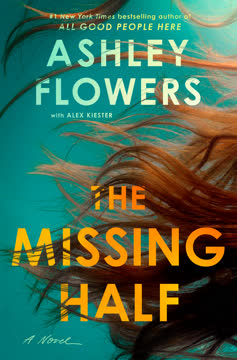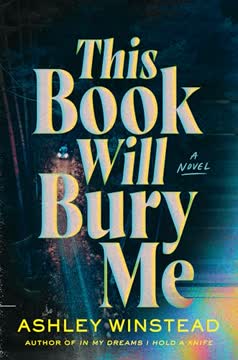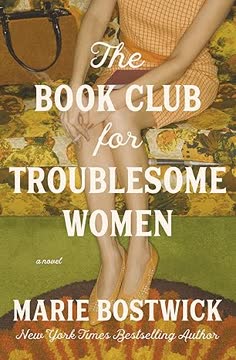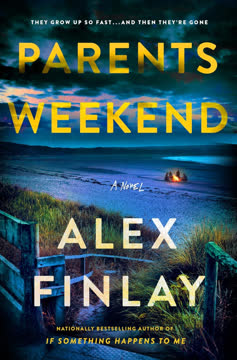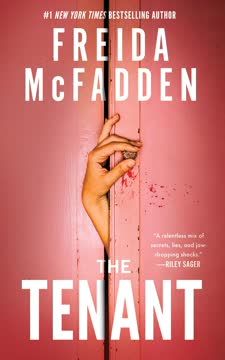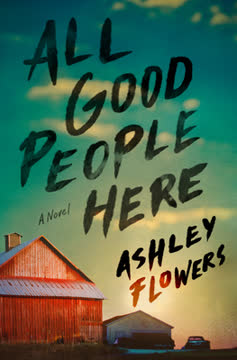Plot Summary
Prologue in the Swamp
The novel opens with a young woman running through a swamp at night, pursued by an unseen threat. She's haunted by memories of her sister and the fleeting happiness they once shared. The terror is palpable, and the prologue ends with a snap of a twig behind her and a single, primal thought: run.
Haunted by the Past
In 2019, Nicole "Nic" Monroe is working a dead-end job at Funland in Mishawaka, Indiana, still reeling from her sister Kasey's disappearance seven years earlier. She's on probation for a DWI, numbing herself with routine and avoiding emotional connections. When a mysterious woman watches her at work, Nic's old suspicions and anxieties resurface, hinting at unresolved trauma and a life derailed by loss.
The Stranger in Blue
The woman in blue, Jenna Connor, confronts Nic after work, revealing that her own sister, Jules, disappeared under similar circumstances as Kasey. Jenna is desperate for answers, believing the two cases are connected. Despite Nic's anger and reluctance, Jenna's persistence and a claim of new evidence force Nic to revisit the pain she's tried to bury.
Sisters' Parallel Disappearances
Through alternating perspectives and flashbacks, we learn about the summer Kasey vanished. Both Kasey and Jules were responsible, steady young women who suddenly began acting withdrawn and fearful before disappearing. Their cars were found abandoned, personal belongings left behind, and no trace of them was ever found. The similarities in their cases suggest a connection, but the police and families have never found the missing link.
Theories and Suspects
The prevailing theory is that the perpetrator was someone on the periphery of the girls' lives—familiar, but not close. Police focus on profiling, but the investigation stalls. Jenna and Nic, frustrated by the lack of progress, decide to dig into their sisters' pasts, jobs, and social circles, searching for any overlap or overlooked detail.
Unraveling Old Wounds
As Nic and Jenna compare notes, they realize both Kasey and Jules had periods of isolation and fear before they vanished. They track down Lauren, Kasey's best friend, and discover she abruptly quit her job at the record store next to the barbecue place where Jules once worked. The girls' lives, once thought separate, begin to overlap in unexpected ways.
The Memory Returns
Nic, haunted by AA meetings and her own guilt, finally remembers that Kasey was acting scared and withdrawn before her disappearance. This matches Jenna's account of Jules. The realization that both sisters were afraid before they vanished reignites the investigation and points to a possible shared threat.
A Fragile Alliance
Despite initial mistrust—especially after Jenna's lie about a diary—the two women form a partnership, driven by the hope of finding answers. They focus on the businesses where their sisters worked: a record store and a barbecue restaurant that once shared a wall. They discover that Lauren, Kasey's friend, worked at both places, and that a man named Steve McLean managed the restaurant during both girls' tenures.
The Search for Lauren
Nic and Jenna struggle to contact Lauren, who ignores their messages. They track her to church, where she reluctantly agrees to talk. Lauren reveals that Steve McLean, known as "Skeevy Steve," was a predatory manager who made the girls uncomfortable. She gave his name to the police, but nothing came of it.
Church Confrontation
During a tense conversation outside church, Lauren reveals she left the record store to escape Kasey, hinting at a falling out. She also confirms that McLean was present during both girls' employment. The police, however, dismissed him as a suspect, relying on profiling and a shaky alibi.
The Name: Steve McLean
Jenna and Nic dig into McLean's background, discovering a history of violence, intimidation, and sexual assault. Despite this, the police never seriously pursued him, convinced by his alibi and their own assumptions. The women decide to confront McLean directly at the restaurant where he still works.
Digging Up the Past
At Mesquite Barbecue, Nic and Jenna meet McLean, who is disturbingly nonchalant and even flirtatious. He remembers Kasey and Lauren, and his comments suggest he knows more than he lets on. The encounter is chilling, and Nic's anger boils over, leading to a public confrontation.
The Confrontation at Mesquite
After the confrontation, Nic and Jenna realize they may have put themselves—and Lauren—in danger. Lauren is threatened at her daughter's playground, receiving a chilling message to stop talking about Kasey. The threat could have come from McLean, but suspicion also falls on Brad, Nic's family friend and former boss.
The Predator Among Us
Under pressure, Lauren confesses that Kasey was having an affair with Brad the summer she disappeared. Sandy, Brad's wife, discovered the affair and paid Kasey to end it. Brad, desperate to keep the secret, threatened Lauren's daughter. The revelation shatters Nic's trust and upends her understanding of the case.
Following the Suspect
Nic investigates Brad's alibis for the nights Kasey and Jules disappeared, only to find they don't hold up. Brad's proximity and behavior make him a prime suspect, but when confronted, he and Sandy admit to the affair and the payoff, but deny involvement in the disappearances. The focus shifts back to McLean.
The Truth About Lauren
As Nic and Jenna dig deeper, they realize everyone has been lying to protect themselves or others. Lauren lied to protect Kasey, Brad lied to protect himself, and even Nic's memories are unreliable. The investigation becomes a tangle of secrets, guilt, and shifting blame.
Threats and Paranoia
Jenna and Nic feel increasingly threatened—by McLean, Brad, and the weight of their own discoveries. Jenna, especially, becomes obsessed with finding proof against McLean, even as she begins to pull away from Nic, citing her mother's illness as a reason to step back.
The Affair Revealed
Nic, left alone, continues the investigation and discovers that Jenna has been lying about her mother's cancer being terminal. Jenna is secretly pursuing McLean, planning to take justice into her own hands. Nic breaks into Jenna's house and uncovers the truth: Jenna's sister Jules was raped by McLean, and Jenna is planning to kill him.
The Playground Warning
Realizing Jenna is about to commit murder, Nic hides in the back of Jenna's truck as she drives to confront McLean. But when they arrive, it's not McLean who answers the door—it's Kasey, alive and living under a new identity.
The Car and the Clues
Jenna accuses Kasey of killing Jules in a hit-and-run and faking her own disappearance to cover it up. Kasey confesses: Nic, drunk, was the one who hit Jules, and Kasey staged both disappearances to protect her sister. Jenna, consumed by grief and rage, pulls a gun on Kasey.
The Final Alibi
In a moment of crisis, Nic intervenes, killing Jenna to save Kasey. The sisters, now both complicit in death, must cover up the crime together. They dispose of Jenna's body in the same swamp where Jules's remains lie, bound forever by guilt and secrecy.
The Realization
In the aftermath, Nic and Kasey confront the reality of what they've done. Their love for each other is both their salvation and their curse. They plan to disappear together, starting new lives, haunted by the knowledge that the wrong sisters survived.
Jenna's Secret
The narrative closes with Nic reflecting on the nature of sisterhood, guilt, and the lies we tell to protect those we love. The cycle of trauma and secrecy continues, leaving the reader to question whether justice or truth was ever truly possible.
The Deadly Reunion
The final image is of Nic and Kasey, bound together by blood and shared crimes, driving away from the swamp where they have buried the evidence of their sins. The story ends with the chilling realization that sometimes, the greatest danger comes from those we love most.
The Last Confession
In the end, the missing half is not just the lost sisters, but the missing pieces of ourselves—the parts we hide, the secrets we keep, and the lengths we'll go to protect the ones we love, even if it means becoming the very thing we fear.
Characters
Nicole "Nic" Monroe
Nic is the protagonist, a young woman whose life was shattered by her sister Kasey's disappearance. She is deeply traumatized, struggling with addiction, legal trouble, and a sense of purposelessness. Nic's relationship with Kasey is the emotional core of the novel—she idolizes her sister, but is also stunted by Kasey's overprotectiveness. Nic's journey is one of painful self-discovery, as she is forced to confront her own role in the tragedy and the consequences of being shielded from the truth. Her psychological arc is a descent into guilt and complicity, culminating in the ultimate act of violence to protect her sister.
Kasey Monroe
Kasey is the missing half—both literally and metaphorically. She is responsible, nurturing, and always the caretaker, but her need to protect Nic leads her to make devastating choices. Kasey's affair with Brad, her decision to cover up Jules's death, and her faked disappearance are all motivated by a twisted sense of love and sacrifice. Her psychological complexity lies in her ability to rationalize morally ambiguous actions for the sake of her sister, ultimately becoming both victim and perpetrator.
Jenna Connor
Jenna is Jules's older sister, driven by grief and a desperate need for answers. She is methodical, resourceful, and emotionally raw, her life consumed by the search for her sister's killer. Jenna's alliance with Nic is fraught with tension, as she oscillates between empathy and manipulation. Her psychological unraveling is triggered by the revelation of Jules's rape and the realization that justice may never come. Jenna's final act—attempting to kill Kasey—reveals the corrosive power of grief and the dangers of obsession.
Jules Connor
Jules is the other "Missing Mishawaka Girl," whose disappearance sets the plot in motion. Through memories and revelations, we learn she was raped by Steve McLean, which led to her withdrawal and eventual death. Jules is a symbol of innocence lost and the devastating impact of violence. Her fate haunts both Jenna and Nic, driving them to the brink of destruction.
Steve McLean
McLean is the predatory manager who worked at both the barbecue restaurant and the record store. He is manipulative, charming, and deeply dangerous, with a history of violence and sexual assault. McLean represents the threat lurking on the periphery of women's lives—the man everyone suspects but no one can prove guilty. His presence is a constant source of fear and suspicion, but in the end, he is not the direct cause of the sisters' disappearances.
Brad Andrews
Brad is Nic's boss and a close family friend, whose affair with Kasey adds layers of betrayal and complexity to the narrative. He is weak, self-serving, and ultimately cowardly, willing to threaten others to protect his secret. Brad's actions set off a chain of events that contribute to Kasey's decision to disappear, making him both a red herring and a catalyst.
Sandy Andrews
Sandy is Brad's wife, who discovers the affair and pays Kasey to end it. She is pragmatic, calculating, and fiercely protective of her family's reputation. Sandy's willingness to cover up the truth and provide Brad with an alibi highlights the ways in which women are often complicit in maintaining the status quo, even at great personal cost.
Lauren Perkins (Tate)
Lauren is Kasey's former best friend, whose shifting memories and reluctance to talk complicate the investigation. She is a symbol of the ways people move on from tragedy, reinventing themselves and leaving the past behind. Lauren's fear and silence are both understandable and infuriating, reflecting the broader community's failure to confront uncomfortable truths.
Mrs. Connor
Mrs. Connor is a minor but psychologically significant character, representing the corrosive effects of grief and mental illness. Her relationship with Jenna is toxic, marked by neglect and emotional abuse. Her presence underscores the generational trauma that haunts the novel.
Banksy (the cat)
Banksy, the one-eyed shelter cat, is a recurring motif representing Nic's longing for connection and her inability to care for herself or others. His adoption by someone else is a turning point, forcing Nic to confront her failures and begin the process of healing.
Plot Devices
Dual Timelines and Unreliable Narration
The novel employs a dual timeline structure, alternating between the present-day investigation and flashbacks to the summer of the disappearances. This allows the reader to piece together the mystery alongside the characters, while also highlighting the unreliability of memory and the ways trauma distorts perception. Nic's recollections are especially suspect, and key revelations hinge on her recovering or reinterpreting past events.
Red Herrings and Shifting Suspects
The narrative is driven by a series of red herrings—Steve McLean, Brad, even Lauren—each of whom is plausible as the villain at different points. The police's reliance on profiling and alibis is critiqued, as is the community's tendency to focus on the "periphery" rather than the uncomfortable truths at the center.
Sisterhood as Motif and Mirror
The relationship between Nic and Kasey is mirrored by that of Jenna and Jules, with both pairs defined by love, rivalry, and sacrifice. The motif of "the missing half" recurs throughout, symbolizing not just the lost sisters but the parts of ourselves we hide or lose to trauma. The poem about two branches of the same tree encapsulates this theme.
Violence, Guilt, and the Cycle of Secrecy
The plot is propelled by acts of violence—accidental and intentional—and the subsequent cover-ups. Each character's attempt to protect themselves or others only deepens the cycle of guilt and secrecy, leading to further tragedy. The final act of violence—Nic killing Jenna—completes the cycle and leaves the survivors forever changed.
Social Critique and Media Sensationalism
The novel critiques the media's role in shaping public perception, highlighting the ways in which certain victims are valorized or vilified based on appearance, class, and narrative convenience. The community's failure to confront the reality of violence against women is a recurring undercurrent.
Analysis
Ashley Flowers crafts a narrative that is as much about the lies we tell to protect those we love as it is about the search for truth. The novel interrogates the limits of memory, the dangers of obsession, and the ways in which trauma ripples through families and communities. By centering the story on two pairs of sisters—one lost, one left behind—Flowers explores the duality of love and destruction, showing how the desire to shield others can lead to devastating consequences. The ultimate revelation—that the real monster was not a stranger but the result of a tragic accident and a web of well-intentioned lies—forces the reader to confront uncomfortable questions about guilt, responsibility, and the impossibility of closure. In the end, The Missing Half is a meditation on the cost of survival and the ways in which, sometimes, the wrong people are left to carry the burden of the past.
Last updated:
FAQ
Synopsis & Basic Details
What is The Missing Half about?
- Two sisters vanish years apart: The story follows Nic Monroe, whose sister Kasey disappeared seven years ago, as she teams up with Jenna Connor, whose own sister Jules vanished under similar circumstances two weeks prior to Kasey. Their joint investigation uncovers dark secrets connecting their sisters' lives and deaths.
- A search for truth and justice: Driven by unresolved grief and suspicion, Nic and Jenna delve into their sisters' pasts, challenging police theories and confronting individuals who may hold clues, leading them down a dangerous path of discovery.
- Unreliable memories and hidden betrayals: The narrative explores the impact of trauma on memory and perception, revealing layers of deception and self-preservation among those closest to the missing girls, ultimately forcing Nic to confront devastating truths about her own past and her sister.
Why should I read The Missing Half?
- Intricate mystery with shocking twists: The novel masterfully weaves together dual timelines and shifting perspectives, constantly challenging reader assumptions and building suspense towards a series of unexpected and impactful revelations about the disappearances.
- Deep dive into trauma and sisterhood: Beyond the crime plot, the book offers a raw and unflinching look at the psychological toll of loss, the complexities of family relationships, and the extreme lengths people will go to protect those they love, making for a powerful emotional core.
- Critique of societal responses to violence: The story subtly critiques how media sensationalizes tragedy and how communities often fail victims, particularly women, highlighting themes of victim-blaming and the invisibility of suffering.
What is the background of The Missing Half?
- Set in the American Midwest: The story takes place primarily in Mishawaka, Indiana, and surrounding areas like South Bend and Osceola, portraying a small-town environment where secrets are hard to keep and reputations are easily judged.
- Focus on cold cases and police procedure: The narrative engages with the realities of cold case investigations, showing the limitations of initial police work, profiling theories, and the frustration families face when leads run dry.
- Exploration of generational trauma: The book touches upon the lasting impact of family dysfunction and secrets, showing how past events, like parental neglect or hidden affairs, can contribute to a cycle of pain and destructive behavior across generations.
What are the most memorable quotes in The Missing Half?
- "We are not two, we are one.": This lyric from The Kinks' song "Strangers," found on Kasey's bumper sticker and a mix CD, becomes a central motif symbolizing the deep, almost inseparable bond between sisters, tragically echoing in the intertwined fates of Kasey and Jules, and ultimately, Nic and Kasey.
- "She was going to be an artist, did you know that? She was supposed to have a goddamn life.": Jenna's anguished cry about her sister Jules reveals the profound grief and sense of stolen potential that fuels her desperate search for justice, highlighting the human cost behind the sensationalized headlines.
- "You killed Jules! Okay? Without me, you'd be in fucking prison.": Kasey's explosive confession to Nic shatters Nic's perception of her sister and herself, revealing the ultimate act of protection Kasey undertook and forcing Nic to confront her own unwitting role in the tragedy and its cover-up.
What writing style, narrative choices, and literary techniques does Ashley Flowers use?
- Alternating perspectives and timelines: Flowers employs a dual narrative structure, shifting between Nic's present-day investigation and flashbacks to the summer of Kasey's disappearance, building suspense and revealing information incrementally.
- Unreliable narration: Nic's perspective is often clouded by trauma, denial, and alcohol, leading to fragmented or misremembered events that are crucial to the plot's twists and the theme of subjective truth.
- Psychological realism and emotional intensity: The prose focuses heavily on Nic's internal state, detailing her anxiety, paranoia, self-loathing, and moments of raw grief, immersing the reader in her emotional turmoil and making her reactions, even extreme ones, feel psychologically grounded.
Hidden Details & Subtle Connections
What are some minor details that add significant meaning?
- The oil change sticker and odometer reading: The seemingly mundane detail of the mileage difference between the oil change date (August 2nd) and the disappearance date (August 17th) reveals over 500 unexplained miles on Kasey's car, providing concrete evidence that she was traveling extensively in the weeks prior, a key clue missed by the initial investigation.
- The bait shop receipt address: The handwritten address on the back of a gas station receipt found in Kasey's jean jacket pocket places her near Brad's lake house on the night she disappeared, directly contradicting Brad's initial alibi and linking Kasey's movements to the Andrews family property.
- Banksy the one-eyed cat: Nic's recurring visits to Banksy at the animal shelter symbolize her deep-seated need for connection and her fear of commitment or failure; his eventual adoption by someone else serves as a catalyst for Nic to confront her pattern of giving up and motivate her to see the investigation through.
What are some subtle foreshadowing and callbacks?
- The prologue in the swamp: The opening scene of a girl running through a swamp, haunted by memories of her sister, directly foreshadows the novel's climax where Nic and Kasey dispose of Jenna's body in a similar location, linking the beginning and end through themes of escape, secrecy, and sisterhood.
- Kasey's warning to Nic: Kasey telling Nic to "Be careful tonight, okay? Don't drink too much. Don't, you know, go anywhere alone" subtly foreshadows the danger Nic faces due to her drinking and isolation, but also, in retrospect, reveals Kasey's own fear stemming from the accident and her knowledge of the risks of being alone on the road.
- The recurring phrase "Missing Mishawaka Girls": This media-coined term, initially used to link Kasey and Jules as victims of a potential serial killer, becomes tragically ironic as the truth reveals their connection is rooted not in a shared perpetrator, but in a shared, fatal accident and subsequent cover-up orchestrated by one of the "missing" girls.
What are some unexpected character connections?
- Kasey's affair with Brad Andrews: The revelation that Nic's family friend and boss, Brad, was having a secret affair with Kasey adds a layer of betrayal and complexity, shifting suspicion and highlighting the hidden lives behind seemingly normal facades.
- Sandy Andrews's knowledge and involvement: Brad's wife, Sandy, is revealed to have known about the affair and even paid Kasey to end it, demonstrating her pragmatic and protective nature and showing how she actively participated in concealing the truth to safeguard her family's reputation.
- Nic's unwitting role in Jules's death: The most shocking connection is that Nic, while drunk driving, was the one who accidentally hit and killed Jules Connor, making her the catalyst for the entire chain of events and linking her directly to the tragedy she spent years investigating.
Who are the most significant supporting characters?
- Brad and Sandy Andrews: Beyond being red herrings, their actions (the affair, the payoff, the threat to Lauren) are direct catalysts for Kasey's decision to disappear and highlight the theme of how seemingly respectable people can hide dark secrets and prioritize self-preservation over truth.
- Lauren Perkins (Tate): Kasey's former best friend serves as a crucial, albeit reluctant, witness whose fragmented memories and eventual fear reveal key pieces of the puzzle, including the existence of "Skeevy Steve" and the affair, while also symbolizing the desire to escape a traumatic past.
- Steve McLean: As "Skeevy Steve," his history of predatory behavior and connection to both girls' workplaces makes him a compelling suspect and embodies the real-world dangers women face, even if he wasn't directly responsible for the disappearances themselves.
Psychological, Emotional, & Relational Analysis
What are some unspoken motivations of the characters?
- Kasey's need to protect Nic: Kasey's primary, often unspoken, motivation is a deep-seated, almost maternal need to shield her younger sister, Nic, from pain and consequences, driving her to make increasingly drastic decisions, including covering up Jules's death and faking her own disappearance.
- Jenna's pursuit of violent justice: While outwardly seeking truth, Jenna's underlying motivation is fueled by consuming grief and rage over Jules's rape and death, leading her to bypass legal channels and plan a violent act of revenge against Steve McLean, and ultimately, Kasey.
- Nic's desire for validation and care: Nic's self-destructive behavior, reliance on alcohol, and initial reluctance to investigate stem from deep-seated self-loathing and a longing for the unconditional care Kasey provided, making her search for answers also a search for her lost sense of self and security.
What psychological complexities do the characters exhibit?
- Trauma-induced dissociation and memory distortion: Nic exhibits classic signs of trauma, including emotional numbing ("numbness is better than pain"), paranoia, and fragmented or unreliable memories, particularly surrounding the night of the accident, highlighting how the mind protects itself from unbearable truths.
- Rationalization of morally ambiguous actions: Kasey demonstrates the psychological complexity of rationalizing horrific choices (covering up a death, abandoning her family) as necessary sacrifices for a perceived greater good (protecting Nic), revealing the dark side of fierce loyalty.
- Grief transforming into destructive obsession: Jenna's character arc shows how unresolved grief and the pursuit of vengeance can consume a person, leading to manipulative behavior (lying about her mom) and ultimately, a plan for murder, illustrating the psychological toll of unchecked trauma and anger.
What are the major emotional turning points?
- Jenna's revelation about Jules's rape: Learning that Jules was raped by Steve McLean is a pivotal emotional turning point for Jenna, transforming her search for answers into a quest for violent retribution and leading her to conceal this truth from Nic to protect her.
- Nic discovering Kasey is alive: The moment Nic hears Kasey's voice is an overwhelming emotional climax, shifting her entire reality from years of mourning to the shock and confusion of reunion, immediately followed by anger and betrayal.
- Kasey's confession about the accident: Kasey revealing that Nic was the one who hit Jules is the ultimate emotional devastation for Nic, forcing her to confront her deepest fears about herself and shattering her perception of her sister's disappearance, leading to a breakdown and acceptance of shared guilt.
How do relationship dynamics evolve?
- Nic and Jenna's alliance: Their relationship evolves from initial mistrust and manipulation (Jenna's lie about the diary) to a genuine bond of shared purpose and burgeoning friendship, only to be shattered by Jenna's deeper deception about Jules's rape and her plan for revenge, culminating in Nic's fatal act.
- Nic and Kasey's sisterhood: Defined by Kasey's overprotectiveness and Nic's reliance in childhood, their bond is seemingly severed by Kasey's disappearance. Their reunion is fraught with anger over Kasey's lies and abandonment, but ultimately, their shared crime and confession forge a new, darker, and unbreakable bond based on mutual complicity and survival.
- Nic's relationships with Brad and Sandy: Nic's view of Brad and Sandy shifts dramatically from surrogate family figures who supported her grief to betrayers who hid secrets about Kasey and prioritized their own reputation, leading to a complete rupture of trust and affection.
Interpretation & Debate
Which parts of the story remain ambiguous or open-ended?
- The ultimate fate of Nic and Kasey: While they escape the immediate consequences and plan to disappear together, the ending leaves their long-term future uncertain, including whether they will ever truly escape their guilt or if their shared secret will eventually catch up to them.
- The extent of Brad and Sandy's knowledge: Although they confess to the affair and payoff, it remains somewhat ambiguous whether they ever suspected Kasey might have been involved in Jules's disappearance or if they genuinely believed she had simply run away with the money.
- The future of Nic's relationship with her father: After their disastrous conversation and Nic's discovery of Kasey's survival, the state of Nic's relationship with her emotionally distant father is left unresolved, adding another layer of personal loss and uncertainty.
What are some debatable, controversial scenes or moments in The Missing Half?
- Kasey's decision to cover up Jules's death and fake her own disappearance: Readers may debate the morality of Kasey's actions, weighing her motivation (protecting Nic) against the devastating impact her choices had on her family and Jules's family.
- Sandy's decision to pay Kasey and provide a false alibi for Brad: Sandy's actions, driven by a desire to protect her family's reputation, raise questions about complicity and the lengths people will go to maintain appearances, even when faced with tragedy.
- Nic's act of killing Jenna: The climax where Nic kills Jenna to save Kasey is highly controversial, prompting debate about whether it was a justifiable act of self-defense (of Kasey) or a tragic murder driven by the complex, destructive nature of their relationships.
The Missing Half Ending Explained: How It Ends & What It Means
- The Climax: Truth and Fatal Choices: The Missing Half ending explained reveals that Kasey Monroe is alive and faked her disappearance. She confesses that Nic, while drunk driving, accidentally hit and killed Jules Connor. Kasey covered up the accident and staged both disappearances to protect Nic and herself. When Jenna Connor, having pieced together the truth about Jules's death and Kasey's survival, confronts Kasey with a gun, Nic intervenes, killing Jenna with a hammer to save her sister.
- The Aftermath: Shared Guilt and Escape: Nic and Kasey, now bound by shared crimes (covering up Jules's death, Nic killing Jenna), dispose of Jenna's body in the same swamp where Kasey hid Jules's remains years earlier. They decide to disappear together, planning to start new lives under new identities, forever linked by their secrets and the violence they committed.
- Thematic Resonance: The Cycle Continues: The ending underscores the novel's core themes of sisterhood, protection, guilt, and the corrosive power of secrets. Kasey's initial act of protection leads to a cycle of lies and violence that culminates in Nic's own act of protection (killing Jenna). The final image of the sisters escaping together, haunted by their actions and the bodies left behind, suggests that while they have survived, they are forever changed and may never truly find peace or escape the consequences of their choices.
Review Summary
The Missing Half receives mostly positive reviews, praised for its compelling plot, emotional depth, and unexpected twists. Readers appreciate the exploration of sisterhood, grief, and addiction. The audiobook narration is highly recommended. Some criticize the pacing and find the ending implausible. Overall, it's considered an improvement over Flowers' debut novel, with layered characters and a satisfying conclusion. The book is described as a psychological thriller that keeps readers guessing until the final page.
Similar Books
Download PDF
Download EPUB
.epub digital book format is ideal for reading ebooks on phones, tablets, and e-readers.
